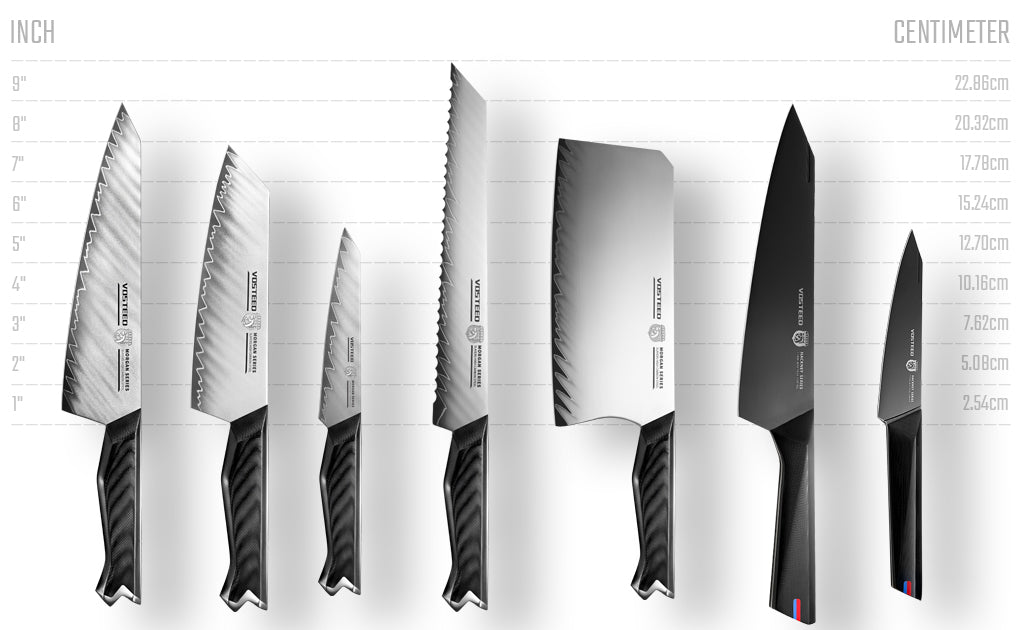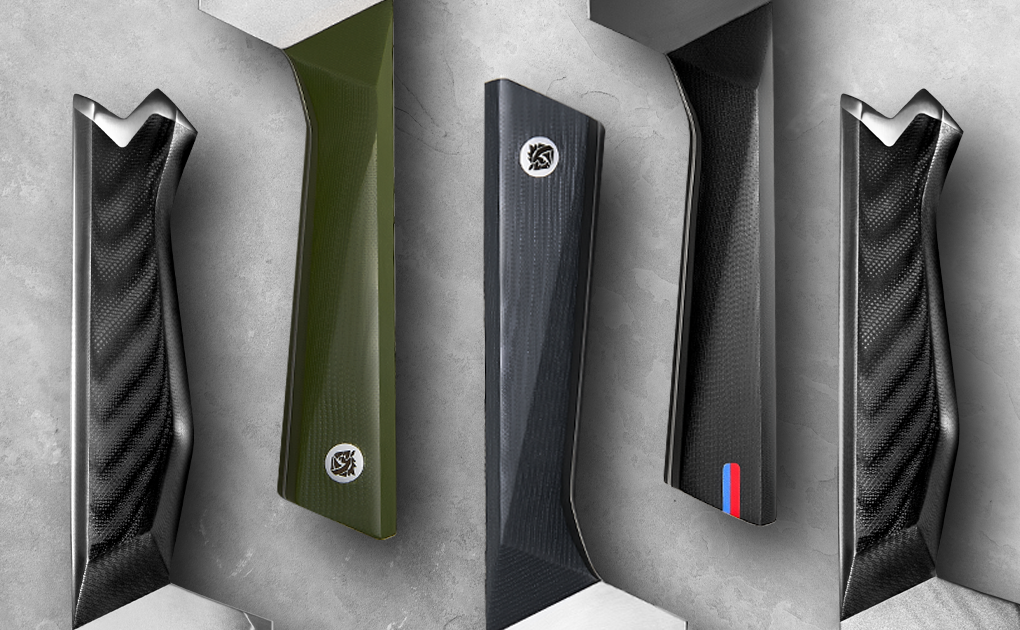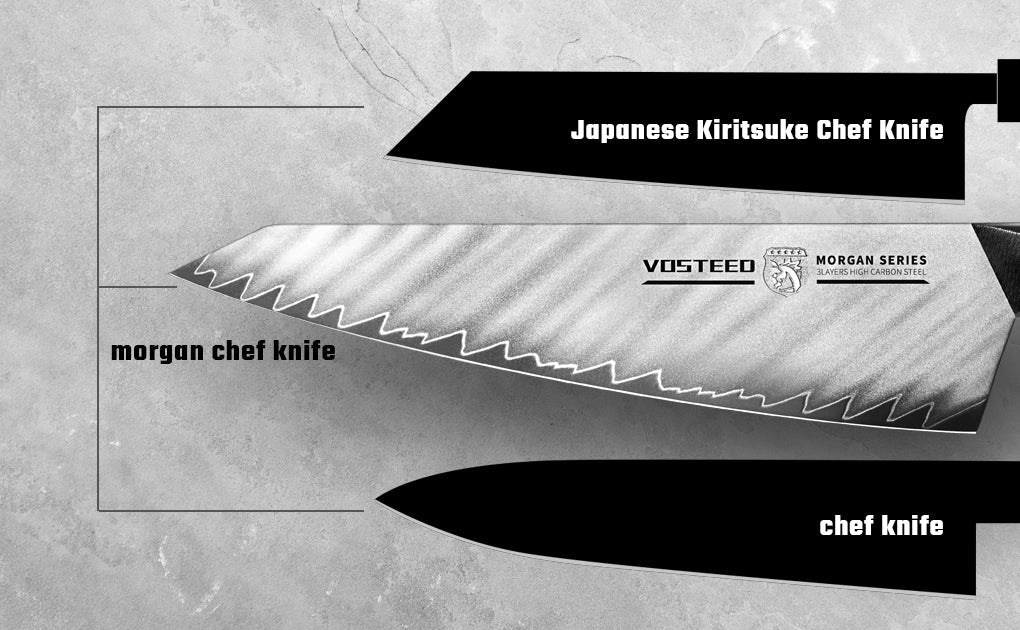Is a sharp knife always a good knife? Well, a good knife is about more than just its sharpness. It can get quite complicated when you're faced with considerable choices in the market. A chef's knife is like a good friend; you need to spend time with it. Often, you only realize you've been working with less-than-ideal knives for a long time when you finally start using a truly good one.
When choosing a knife that's reliable and fits you, blade material and handle design certainly matter. But please don’t forget, the length, width, and thickness of the blade also determine the comfort and efficiency of your cooking. Let's share a few tips to make this measurable.
Why Chef's Knife Size is Crucial
Before we dive into the specific dimensions, let's first understand why the size of a chef's knife is so critical. The right size can lead to:
- Better Control: Allowing you to handle cutting tasks with greater ease.
- Higher Efficiency: A knife that matches the size of your ingredients and workload can speed up prep time.
- Increased Safety: The appropriate size can reduce the risk of operational errors.
- A More Comfortable Experience: Avoiding fatigue from using a knife that's too large or too small.
Decoding the Core Dimensions of a Chef's Knife: Length, Thickness, and Width
The size of a chef's knife is primarily defined by these three dimensions:
Blade Length: The Decider of Your Cutting Range
Blade length is measured from the tip to the heel of the blade, not including the handle. So, an 8-inch chef's knife means the blade itself is 8 inches long.
- Common Length Range: Chef's knives typically range from 6 to 12 inches (approx. 15 cm to 30 cm) in length.
- The Golden Size for Home Kitchens: For about 99% of home cooking tasks, a 6-8 inch (15-20 cm) chef's knife is the most popular choice. These knives are easier to maneuver and offer high flexibility.
- The Choice of Professional Chefs: Professional chefs, who often need to process large quantities of ingredients, tend to prefer 10-12 inch (25-30 cm) knives. While these can handle more food prep at once, they are heavier and can be harder for an untrained user to control.
Both professional chefs and home cooking enthusiasts agree: a chef knife’s size is vital to its performance and ease of use. The knife's dimensions directly impact your technique and comfort when cutting, slicing, and dicing vegetables and meat. These tasks require a specific “feel” to achieve the best results.
Quick Tip: Just as choosing the right kitchen tools can enhance your cooking experience, selecting the right sized knife for everyday carry is equally important. If you're interested in EDC (Everyday Carry) knives, understanding their size is key.
Blade Thickness (on the Spine): Balancing Strength and Fine Cutting
Blade thickness, usually referring to the thickness of the spine, is the second important factor to consider when choosing a chef's knife.
- Ideal Thickness Reference: For an 8-inch chef's knife, 1/8 inch (approx. 3.2 mm) is a good starting point. For most kitchen knives, a blade thickness of 3/32 inch (approx. 2.4 mm) or more provides good strength.
- The Specificity of Chef's Knives: Since a chef's knife needs to withstand relatively greater pressure, its blade thickness can be slightly higher, but generally does not exceed 3.5 mm.
-
Differences in Style:
a. Japanese-style Chef's Knives (e.g., Gyuto): Usually have thinner blades (possibly as thin as 2.0 mm or even less). This makes them excel at fine slicing and tasks requiring high control, and they also feel sharper. However, thinner blades are less suitable for handling hard bones or heavy chopping.
b. German-style Chef's Knives: Tend to have thicker blades, emphasizing durability and versatility.
Blade Width/Height: Operating Space and Safety Assurance
Blade width (or height), the distance from the cutting edge to the spine, is something that buyers might overlook, but it's fairly important for comfort and safety during cooking.
- General Standard: A chef's knife blade is typically around 1.5 inches (approx. 38 mm) wide. For instance, the popular Victorinox Fibrox chef's knife has a blade width/height of about 55 mm.
- Advantages of a Taller Blade:
a. Ample Finger Space: When gripping the knife to cut vegetables, a taller blade provides more space for your fingers, helping to prevent accidental cuts.
b. Knuckle Clearance: A taller blade also means a larger heel, ensuring enough clearance between your knuckles and the cutting board. This enhances operational comfort and safety.
How to Choose the Right Size Based on Your Needs
Choosing the perfect chef’s knife that makes slicing, dicing, chopping, and mincing more pleasurable and effortless isn't as difficult as you might think. Identify your personal preferences and take the length, width, and thickness into consideration. Here are some key points:
| Consideration Factor | Suggestion |
| Main Cooking Tasks | More fine cutting? Or more processing of large ingredients? The former suits a shorter, thinner knife; the latter a longer, thicker one. |
| Your Hand Size | Those with smaller hands might find a 6-7 inch knife more comfortable, while those with larger hands might prefer 8 inches or more. |
| Kitchen Workspace | Smaller kitchens might not be suitable for overly long knives, which can be cumbersome to maneuver. |
| Personal Preference | Some people prefer a heavier, more substantial knife, while others favor a lighter, more agile one. |
| Experience Level | Beginners are advised to start with a 6-8 inch knife, as it's easier to master techniques and build confidence. |
Conclusion: Finding Your "Ultimate Kitchen Tool"
There isn’t one knife that fits all when choosing a chef's knife size. The key is to understand your personal preferences and consider the three core dimensions: blade length, width, and thickness. Take some time to feel and compare, and you're sure to find that ideal chef's knife that works in harmony with you, adding more joy to your cooking process!
Frequently Asked Questions (FAQ)
Q1: What is the most common chef's knife length for home cooking?
A1: Most home kitchens opt for a 6-8 inch (15-20 cm) chef's knife, which balances maneuverability and versatility.
Q2: How should I choose the blade thickness for a chef's knife?
A2: It depends on your needs. Japanese-style knives are typically thinner, ideal for fine slicing, while German-style knives are thicker and more durable.
Q3: How does blade width (height) affect the use of a chef's knife?
A3: It impacts operational comfort and safety. A wider blade offers better finger protection and more working space.
Q4: What size chef's knife is suitable for a kitchen novice?
A4: It's recommended to start with a 6-8 inch knife, as it's easier to get the hang of and build confidence.
Q5: Is the "size" concept for a chef's knife the same as for EDC (Everyday Carry) knives?
A5: Not entirely. Chef's knife size prioritizes kitchen efficiency and comfort. EDC knife sizing focuses more on portability, legal compliance, and suitability for quick daily tasks.
Q6: For EDC knives, how important is the choice of blade steel?
A6: Extremely important. Blade steel in an EDC knife affects its sharpness retention, durability, corrosion resistance, and ease of sharpening. If you're looking to delve deeper into how specific steel types measure up in these areas, our article, Comparing the Best Pocket Knife Steels, offers a comprehensive comparison.
Q7: How does handle material influence the choice of a knife, whether it's for the kitchen or everyday carry?
A7: Handle material is crucial for grip, comfort, balance, and durability. Different materials offer varied performance in wet conditions, impact resistance, and aesthetics. To help you navigate these choices and find what best suits your needs, we've detailed the pros and cons in our Knife Handle Materials Comparison.
Q8: Can the approach to choosing a chef's knife size be applied to selecting an outdoor fixed blade knife?
A8: There's some overlap, like matching the tool to the task (e.g., larger tasks may need larger knives). However, outdoor fixed blades have vastly different functional priorities and usage scenarios (e.g., chopping wood vs. slicing vegetables) compared to chef's knives.





1 comment
Kristie Cooke
Excellent explanation and insight. I feel more informed and prepared. Thank you for the tutorial.
Leave a comment
All comments are moderated before being published.
This site is protected by hCaptcha and the hCaptcha Privacy Policy and Terms of Service apply.